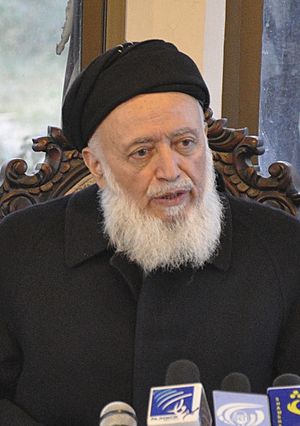Burhanuddin Rabbani facts for kids
Quick facts for kids
Burhanuddin Rabbani
|
|
|---|---|
|
برهانالدین ربانی
|
|

Rabbani in 2010
|
|
| 3rd President of Afghanistan | |
| In office 28 June 1992 – 22 December 2001 Disputed by Mullah Omar (as Supreme Leader) from 27 September 1996 – 13 November 2001 |
|
| Prime Minister |
|
| Vice President |
|
| Preceded by | Mohammad Najibullah |
| Succeeded by | Hamid Karzai |
| Personal details | |
| Born | 20 September 1940 Badakhshan, Afghanistan |
| Died | 20 September 2011 (aged 71) Kabul, Afghanistan |
| Children | 4, including Salahuddin |
| Education | Kabul University (BA) Al-Azhar University (MA, PhD) |
Burhanuddin Rabbani (born September 20, 1940 – died September 20, 2011) was an important Afghan leader and teacher. He served as the President of Afghanistan from 1992 to 1996. He was also president again for a short time in 2001.
Rabbani was born in Badakhshan Province. He studied at Kabul University and later taught there. He helped start a group called Jamiat-e Islami (Islamic Society). This group attracted students like Gulbuddin Hekmatyar and Ahmad Shah Massoud, who became key commanders during the Soviet war in Afghanistan.
After the communist government ended in 1992, Rabbani became President. However, his government faced many challenges and conflicts between different groups. Later, the Taliban took control, forcing Rabbani and his government to leave the capital city, Kabul. He then led the Northern Alliance, a group that fought against the Taliban.
When the Taliban government was removed in 2001, Rabbani briefly returned as President. He then handed over power to Hamid Karzai. In his later years, Rabbani worked for peace in Afghanistan. He led the High Peace Council, trying to talk with the Taliban. He was given the title "Martyr of Peace" by the Afghan parliament.
Early Life and Education
Burhanuddin Rabbani was born in the northern province of Badakhshan Province. His father's name was Muhammed Yousuf. Rabbani was an ethnic Tajik and spoke Persian.
After finishing school in his home province, he went to a religious school in Kabul called Darul-uloom-e-Sharia (Abu-Hanifa). He then studied Islamic Law and Theology at Kabul University, graduating in 1963.
In 1963, Rabbani became a professor at Kabul University. To learn more, he traveled to Egypt in 1966. He studied at Al-Azhar University in Cairo, where he earned his master's degree in Islamic Philosophy. He later returned to Egypt to complete his PhD. In 2004, he received Afghanistan's highest academic award, "Academician."
Political Journey
Rabbani returned to Afghanistan in 1968. He was asked to help organize university students for the Jamiat-e Islami group. Because of his knowledge and support for Islam, he was chosen as the head of Jamiat-e Islami of Afghanistan in 1972. This group was mostly made up of Tajiks.
In 1974, police tried to arrest Rabbani at Kabul University because of his strong Islamic views. But with the help of his students, he escaped to the countryside. He went to Pakistan and helped build up his political party there.
When the Soviets entered Afghanistan in 1979, Rabbani helped lead Jamiat-e Islami in fighting against the government. In 1992, Rabbani's forces were among the first to enter Kabul when the government fell. He became President that year, following an agreement called the Peshawar Accords.
During his time as president, Afghanistan was divided by civil war. In 1996, the Taliban took control of Kabul, and Rabbani was forced to leave. His government continued to be recognized by other countries, even though it only controlled a small part of Afghanistan. For the next five years, he and the Northern Alliance fought against the Taliban.
After the Taliban government was removed in 2001 by the US-led Operation Enduring Freedom, Rabbani returned to Kabul. He briefly served as President again before Hamid Karzai became the interim leader. Later, Rabbani led the High Peace Council, working to bring peace to Afghanistan.
Assassination
On September 20, 2011, Burhanuddin Rabbani was killed in a bomb attack. Two men pretending to be Taliban representatives approached him. They offered a hug and then set off explosives hidden in their turbans. Four other members of Afghanistan's High Peace Council also died in the blast. Rabbani was buried in the Wazir Akbar Khan cemetery.
Afghan officials believed the attack was linked to the Taliban leadership in Pakistan. The Pakistani government said that if Afghan refugees crossed the border and attacked, they were not responsible.
Many world leaders condemned Rabbani's assassination. United States President Barack Obama and NATO military leaders spoke out against it. Japan also offered its sadness. Afghan President Hamid Karzai cut short his trip to the United Nations after Rabbani's death. Rabbani's son, Salahuddin Rabbani, took over his father's role as chairman of the High Peace Council.
Honors and Awards
 Tajikistan :
Tajikistan :  Order of Ismoili Somoni – awarded after his death on September 2, 2021.
Order of Ismoili Somoni – awarded after his death on September 2, 2021.
See also
 In Spanish: Burhanuddin Rabbani para niños
In Spanish: Burhanuddin Rabbani para niños
- Gholam Mohammad Niazi
- Badaber Uprising
- Qadria Yazdanparast
- Mullah Dadullah Front

